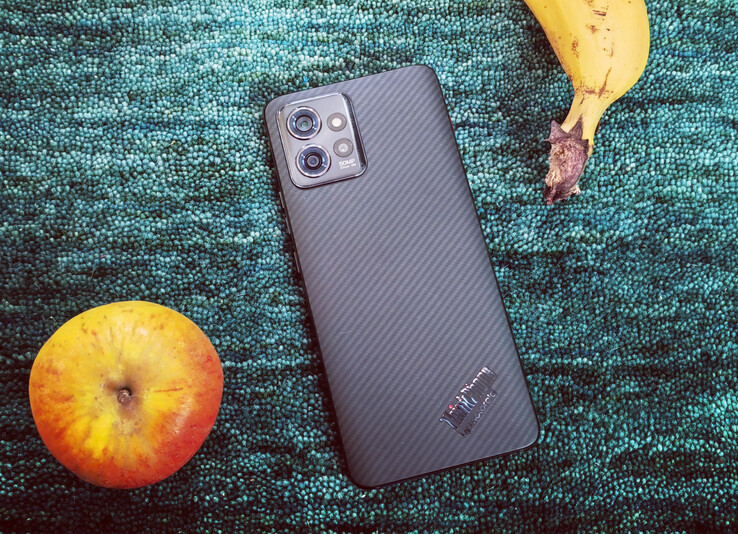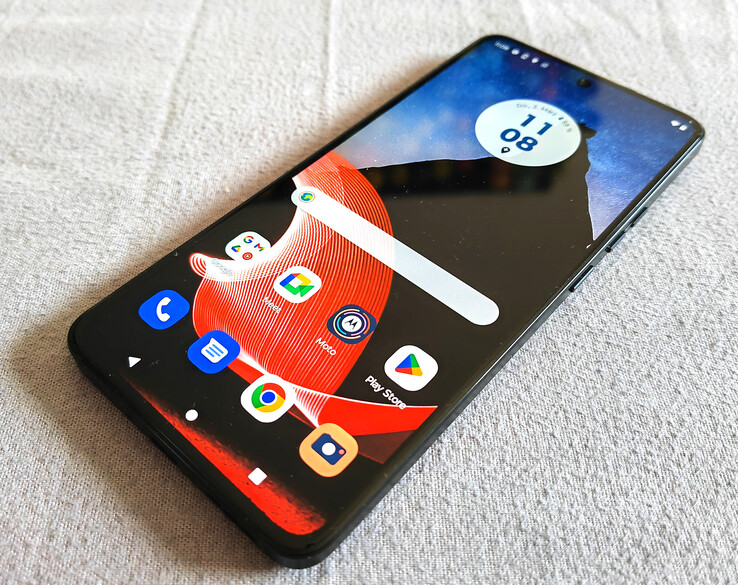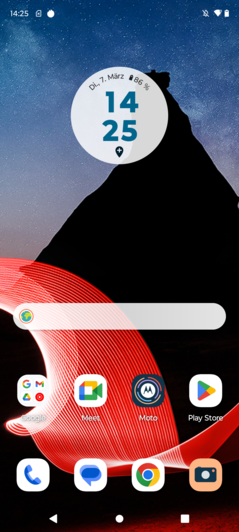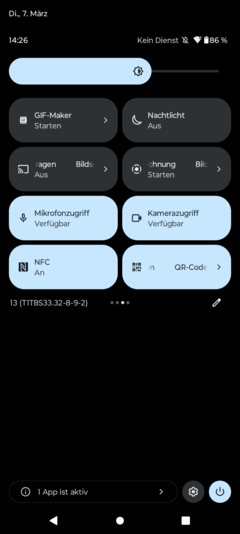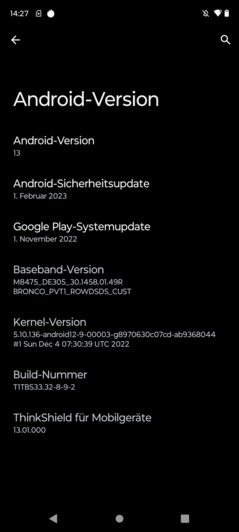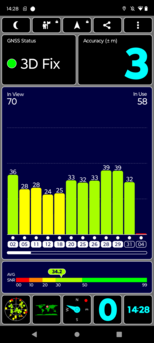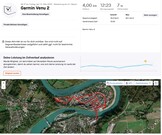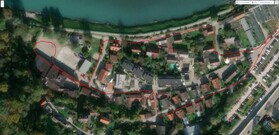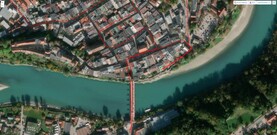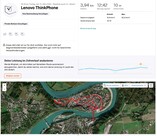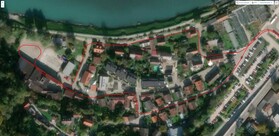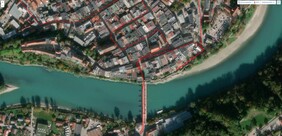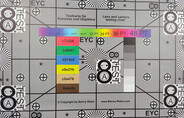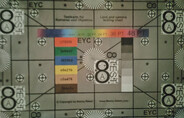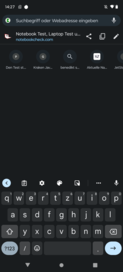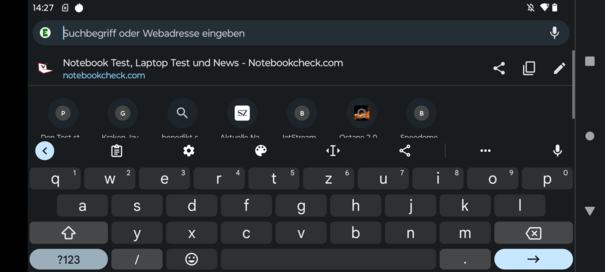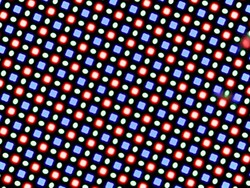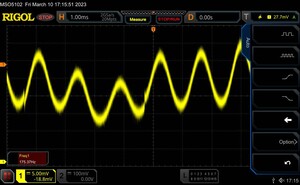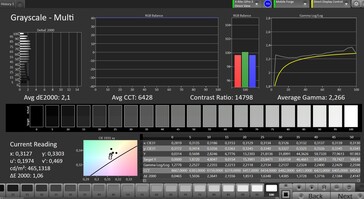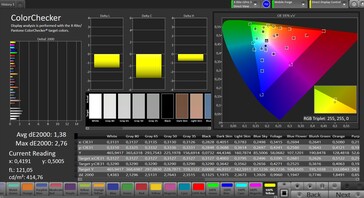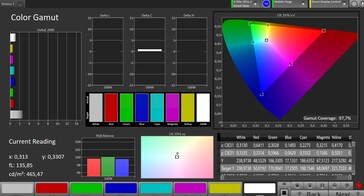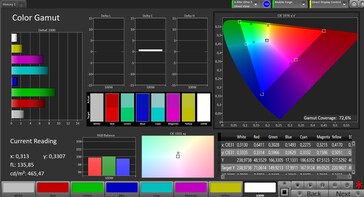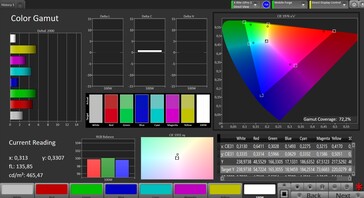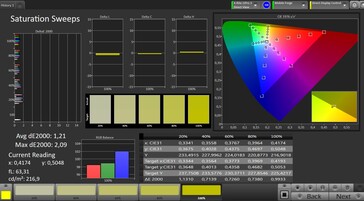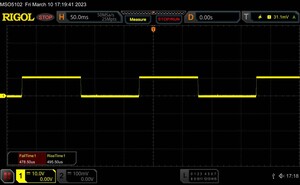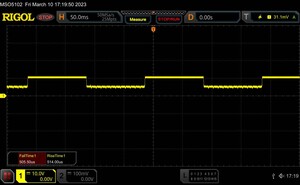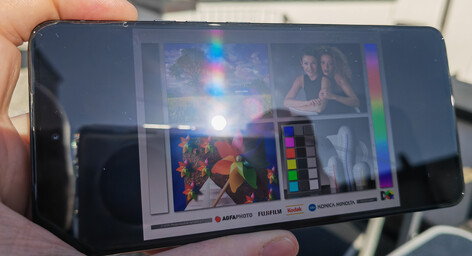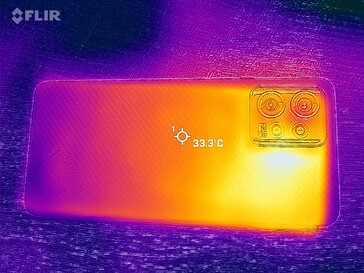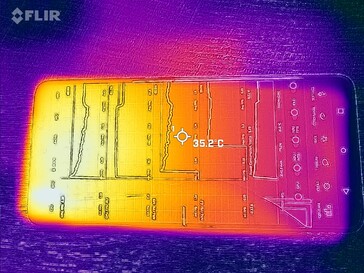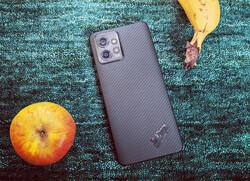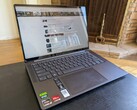Lenovo ThinkPhone by Motorola in review: Business smartphone with IP certification
IBM may not have invented the notebook computer, but it did make a decisive contribution to the triumph of portable computers with its ThinkPad series. While the brand now belongs to Chinese manufacturer Lenovo, the ThinkPads are still classic business notebooks with a long supply of spare parts and modern materials such as carbon.
With the Lenovo ThinkPhone by Motorola, a matching smartphone to the almost legendary business notebook is now coming onto the market. Boasting special software features, a back out of aramid fibers and a high level of security, it should appeal to a business cliente in particular.
However, the SoC dates from the last generation, while smartphones such as the Xiaomi 13 Pro with their more up-to-date processors are currently coming onto the market and can thus benefit from features like WiFi 7. So will the ThinkPhone already be out of date by the time it is released, or is the price of around US$900 justified in other ways? Let's find out.
Possible Competitors in Comparison
Rating | Date | Model | Weight | Drive | Size | Resolution | Price |
|---|---|---|---|---|---|---|---|
| 88.8 % v7 (old) | 03 / 2023 | Motorola ThinkPhone SD 8+ Gen 1, Adreno 730 | 189 g | 256 GB UFS 3.1 Flash | 6.60" | 2400x1080 | |
| 89.2 % v7 (old) | 03 / 2023 | Xiaomi 13 Pro SD 8 Gen 2, Adreno 740 | 229 g | 256 GB UFS 4.0 Flash | 6.73" | 3200x1440 | |
| 89.2 % v7 (old) | 10 / 2022 | Apple iPhone 14 A15, A15 GPU 5-Core | 172 g | 128 GB NVMe | 6.10" | 2532x1170 | |
| 89.3 % v7 (old) | 10 / 2022 | Motorola Edge 30 Ultra SD 8+ Gen 1, Adreno 730 | 198.5 g | 256 GB UFS 3.1 Flash | 6.67" | 2400x1080 | |
| 88.6 % v7 (old) | 07 / 2022 | Honor Magic4 Pro SD 8 Gen 1, Adreno 730 | 215 g | 256 GB UFS 3.1 Flash | 6.81" | 2848x1312 |
Case- Made of aramid and with IP certification
The aramid fibers that Lenovo uses for the back of the ThinkPhone are said to be stronger and lighter than steel; the pattern is also reminiscent of typical carbon fiber products. The back is matte, but still not entirely resistant to fingerprints and grease smudges.
Fans of Lenovo's laptops will be pleased to see the classic ThinkPhone logo, which is rotated about 37 degrees on the bottom right corner on the back and of course corresponds to the ThinkPad logo on the corresponding notebooks. The frame is made of aluminum, which is also used in car manufacturing. As a further reminder of the ThinkPads, Lenovo and Motorola have colored the freely assignable button on the left in red, i.e. in the same color as the TrackPoint, a very practical alternative to the touchpad and mouse that is only available on ThinkPads.
The front is protected by Gorilla Glass Victus and the phone itself is dust- and waterproof according to IP68 and MIL STD 810H. The workmanship of the chassis is top notch, giving it a very high quality look. The Motorola ThinkPhone is also quite light and slim for its size.
Equipment – No microSD reader
The manufacturer uses 256 GB of UFS 3.1 flash as mass storage, plus 8 GB of RAM. This corresponds to the standard of the price range, although 12 GB of RAM is not uncommon in other devices. In Central Europe, there is currently only this one configuration at a price of just under EUR 1000, but models with more RAM and 128 GB or 512 GB of data storage are also available internationally.
An microSD reader for storage expansion is missing, but you can exchange data with nearby devices via NFC, so you can also use mobile payment services such as Google Pay, for example. The USB port has a transfer rate of up to 5 GBit/s and is thus reasonably fast.
Software - Very much stock Android 13
Motorola traditionally uses a relatively unadulterated Android in its smartphones and doesn't pre-install too many third-party apps. The ThinkPhone has apps from Microsoft on the phone, but these can be uninstalled without issue.
Android 13 is preinstalled and the security patches were from February 2023 at the time of review and thus quite up-to-date. Motorola specifies an update cycle of at least two months, which held true during our review. Security updates will be provided until January 2027, and the device will definitely get Android 14.
Lenovo and Motorola also highlight its "ThinkShield for mobile" program, in which, among other things, suppliers are strictly checked and special attention is paid to security right from the design stage of a product. Moto Security also comes preinstalled on the device, an app that bundles all Android security settings and allows for additional measures, such as smartphone encryption or revoking the camera permission for all apps.
Moreover, the ThinkPhone is also particularly suitable for connecting to PCs or even replacing a PC by connecting a monitor, mouse and keyboard. It can be streamed to a PC via Motorola's Ready For Apps, the ThinkPhone can be integrated as a webcam, and data can be transferred via drag and drop.
Of course, several devices in a company can also be managed centrally with the Moto Device Manager.
Communication and GNSS - WiFi 6E on board, but...
The ThinkPhone supports WiFi 6E, so it can also use the 6 GHz band. This worked without any problems under testing with our Asus ROG Rapture AXE11000 reference router, but the transmission rates are comparatively slow, especially in receiving. Despite repeating our test several times, the ThinkPhone only reaches WiFi 6 speed. Sending data works better, but here, too, there are significantly faster smartphones with WiFi 6E.
The connection quality, on the other hand, is solid: Full reception is available directly near the router and even at a distance of 10 meters and through 3 walls, the smartphone still display 3/4 of the signal strength and is not subjectively any slower when loading websites.
The smartphone supports numerous 4G and 5G networks, so that trouble-free operation should be possible when traveling abroad. The signal quality is also very good; regardless of whether indoors or outdoors, the Lenovo ThinkPhone by Motorola always provided stable signal quality in our tests.
| Networking | |
| iperf3 receive AXE11000 | |
| Honor Magic4 Pro | |
| Motorola Edge 30 Ultra | |
| Xiaomi 13 Pro | |
| Apple iPhone 14 | |
| Average of class Smartphone (52 - 1857, n=176, last 2 years) | |
| iperf3 transmit AXE11000 | |
| Honor Magic4 Pro | |
| Xiaomi 13 Pro | |
| Apple iPhone 14 | |
| Motorola Edge 30 Ultra | |
| Average of class Smartphone (49.8 - 1828, n=176, last 2 years) | |
| iperf3 transmit AXE11000 6GHz | |
| Xiaomi 13 Pro | |
| Motorola Edge 30 Ultra | |
| Motorola ThinkPhone | |
| Average of class Smartphone (508 - 1945, n=86, last 2 years) | |
| iperf3 receive AXE11000 6GHz | |
| Xiaomi 13 Pro | |
| Motorola Edge 30 Ultra | |
| Average of class Smartphone (451 - 1864, n=86, last 2 years) | |
| Motorola ThinkPhone | |
Localization of the ThinkPhone takes place via all major satellite networks, but SBAS for more precise positioning is not used. When we step outside, satellite detection is very rapid and our position is immediately pinpointed at an accuracy of a 3 meters.
Of course, we took the ThinkPhone on a bike ride for real-world testing of its tracking capabilities. The smartphone shows minor deviations from the route actually taken, but does its job quite accurately overall. It is thus suitable for worry-free everyday navigation.
Telephony and Voice Quality - Sound rather mediocre
Google's phone app comes preinstalled, but it can be replaced with other apps. The ThinkPhone supports all important functions such as VoLTE or VoWiFi, whereby it automatically and conveniently switches to the cell phone network in VoWiFi mode when emergency calls are made.
Voice quality via the built-in earphones, the speaker, and the hands-free microphone is solid, but by no means perfect. In all scenarios, we experience slightly distorted speech and occasionally short sound dropouts in our test calls, and the sound quality does not improve with VoWiFi either. You understand the other person quite well and the dropouts are rare, but we expect better telephony quality from a high-end phone.
Cameras - ThinkPhone with good pictures
3 camera lenses are found on the back, whereby only 2 can actually be used for photos, while the third is only used to provide depth information. The sensor of the 50-megapixel main camera comes from OmniVision and takes good photos with strong colors that don't look overdone. The autofocus sometimes has problems concentrating on the main subject in the case of close objects, but the overall sharpness of the pictures is convincing.
In low light and high contrasts, the smartphone manages a relatively sharp image. Particularly bright areas are darkened well so that they are not too bright. Overall, however, photos look a little dark.
The wide-angle camera has a resolution of 13 megapixels. It comes from Hynix and takes nice pictures at first glance. However, you should not enlarge them too much, as the details become quite muddy. Hybrid zoom between the two cameras is possible.
Video recordings with the main camera can be made in Full HD, 4K or 8K. 4K offers the most options: here you can choose whether you want to record at 60 or 30 fps and with or without HDR10+. In the viewfinder, the image tends to jitter during recording, but nothing of this is visible in the final material. The brightness adjustment to different situations could be a little smoother, but the autofocus reacts quickly and reliably.
On the front there is a 32-megapixel lens, also from OmniVision. It takes decent selfies in good light, which can also be enlarged a little without losing too much sharpness.
Image comparison
Choose a scene and navigate within the first image. One click changes the position on touchscreens. One click on the zoomed-in image opens the original in a new window. The first image shows the scaled photograph of the test device.
Main camera - plantMain camera - environmentMain camera - low lightMain camera - wide angleIn the lab, the main camera is very sharp in optimal light, even at the edges of the image. Contrasts and fine lines are also reproduced well. At only 1 lux illumination, we like the brightness, but the image is still quite blurry.
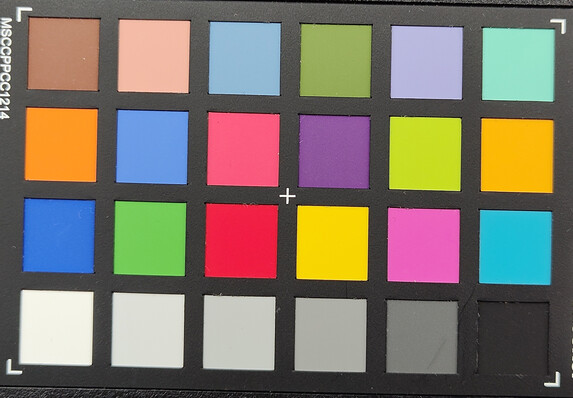
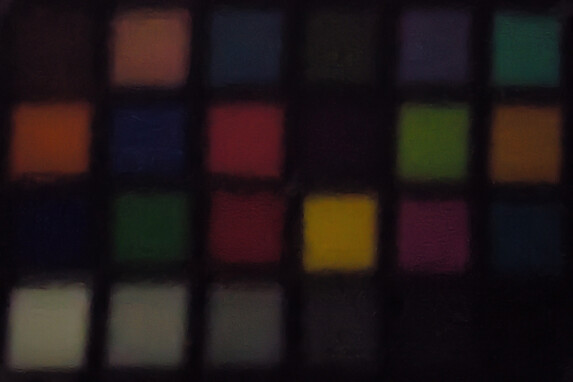
Accessories and Warranty - Quick charger supplied
The ThinkPhone is packed together with a 65-watt charger and a cable with a USB-C connector on each end. A SIM tool is also included. Motorola's German online shop does not currently offer any accessories specially adapted for the device.
The manufacturer offers a 24-month guarantee for devices purchased in the EU. This may differ in other regions and countries, so buyers should double-check before purchasing.
With MotoCare you can extend and expand the warranty in three different stages. In the UK, for example, the maximum level currently costs around £63.99 on Motorola's website and comes with 2 years of accident damage protection.
Input Devices & Operation - Very fast thanks to 144 Hz
The very responsive 144 Hz screen and the fast processor enable almost instantaneous operation within the menus. The standby button and volume rocker are a little narrow and not so pleasant to use in the long run, but they have a high-quality feel and a good pressure point.
The freely assignable button on the left side of the case is easy to detect due to its ribbed surface and can be used for different commands when pressed once or twice.
The fingerprint sensor is hidden behind the screen, but very far down in the case so that only people with large hands can reach it without much trouble. The sensor recognizes a fingerprint very reliably and unlocks the smartphone almost immediately.
Unlocking via facial recognition also works very quickly and reliably, but this is not quite as well protected against manipulation as other methods due to the lack of additional hardware.
Display - High-quality OLED screen
The ThinkPhone comes with an OLED screen with support for HDR 10+, extended Full HD resolution and a frame rate of up to 144 Hz. In our tests with the spectrophotometer and CalMAN software, the screen scores with good brightness values of over 1000 cd/m², but the Xiaomi 13 Pro is capable of a few more candelas if necessary.
The brightness is very even thanks to the self-illuminating diodes.
PWN was detected in our test. At 175.4 Hz, this could definitely lead to problems such as headaches in sensitive people when the screen is used at low brightness. This problem can be mitigated with the "Prevent flickering" option, but we would recommend trying out the screen before purchasing if you have sensitivities in this range.
| |||||||||||||||||||||||||
Brightness Distribution: 94 %
Center on Battery: 1023 cd/m²
Contrast: ∞:1 (Black: 0 cd/m²)
ΔE ColorChecker Calman: 1.38 | ∀{0.5-29.43 Ø4.81}
ΔE Greyscale Calman: 2.1 | ∀{0.09-98 Ø5.1}
97.7% sRGB (Calman 2D)
Gamma: 2.266
CCT: 6428 K
| Motorola ThinkPhone OLED, 2400x1080, 6.6" | Xiaomi 13 Pro OLED, 3200x1440, 6.7" | Apple iPhone 14 OLED, 2532x1170, 6.1" | Motorola Edge 30 Ultra pOLED, 2400x1080, 6.7" | Honor Magic4 Pro OLED, 2848x1312, 6.8" | |
|---|---|---|---|---|---|
| Screen | 14% | -6% | 5% | -39% | |
| Brightness middle (cd/m²) | 1023 | 1230 20% | 835 -18% | 1020 0% | 956 -7% |
| Brightness (cd/m²) | 1024 | 1244 21% | 841 -18% | 1020 0% | 959 -6% |
| Brightness Distribution (%) | 94 | 94 0% | 97 3% | 96 2% | 94 0% |
| Black Level * (cd/m²) | |||||
| Colorchecker dE 2000 * | 1.38 | 1 28% | 1.05 24% | 1 28% | 2.4 -74% |
| Colorchecker dE 2000 max. * | 2.76 | 2.8 -1% | 2.81 -2% | 2.8 -1% | 5.2 -88% |
| Greyscale dE 2000 * | 2.1 | 1.8 14% | 2.6 -24% | 2.1 -0% | 3.3 -57% |
| Gamma | 2.266 97% | 2.24 98% | 2.034 108% | 2.29 96% | 2.26 97% |
| CCT | 6428 101% | 6446 101% | 6616 98% | 6502 100% | 6804 96% |
* ... smaller is better
Screen Flickering / PWM (Pulse-Width Modulation)
| Screen flickering / PWM detected | 175.4 Hz | ||
The display backlight flickers at 175.4 Hz (worst case, e.g., utilizing PWM) . The frequency of 175.4 Hz is relatively low, so sensitive users will likely notice flickering and experience eyestrain at the stated brightness setting and below. In comparison: 53 % of all tested devices do not use PWM to dim the display. If PWM was detected, an average of 8249 (minimum: 5 - maximum: 343500) Hz was measured. | |||
Series of measurements at a fixed zoom level and different brightness settings
In our tests with the spectral photometer and CalMAN software, we ascertained very accurate color reproduction in the "Natural" color profile. The sRGB color space coverage is very good.
Display Response Times
| ↔ Response Time Black to White | ||
|---|---|---|
| 1 ms ... rise ↗ and fall ↘ combined | ↗ 0.5 ms rise | |
| ↘ 0.5 ms fall | ||
| The screen shows very fast response rates in our tests and should be very well suited for fast-paced gaming. In comparison, all tested devices range from 0.1 (minimum) to 240 (maximum) ms. » 3 % of all devices are better. This means that the measured response time is better than the average of all tested devices (20.4 ms). | ||
| ↔ Response Time 50% Grey to 80% Grey | ||
| 1 ms ... rise ↗ and fall ↘ combined | ↗ 0.5 ms rise | |
| ↘ 0.5 ms fall | ||
| The screen shows very fast response rates in our tests and should be very well suited for fast-paced gaming. In comparison, all tested devices range from 0.165 (minimum) to 636 (maximum) ms. » 3 % of all devices are better. This means that the measured response time is better than the average of all tested devices (31.9 ms). | ||
Performance - No longer up to date, but fast
The Qualcomm Snapdragon 8+ Gen 1 is a high-end processor from last year, so the performance differences to the current Snapdragon 8 Gen 2 in the Xiaomi 13 Pro are visible in the benchmarks, but these are only likely to be noticed by people who use extremely demanding apps on their smartphone or do a lot of multitasking.
In general, there is hardly anything that is likely to bring the Lenovo ThinkPhone to its limits: performance is sufficient for smooth operation in most cases. It has to be said, however, that the somewhat scarce 8 GB of RAM costs our test device some points in the benchmarks, as can be seen in a direct comparison with the Motorola Edge 30 Ultra.
| UL Procyon AI Inference for Android - Overall Score NNAPI | |
| Honor Magic4 Pro | |
| Average Qualcomm Snapdragon 8+ Gen 1 (3291 - 84787, n=21) | |
| Average of class Smartphone (3769 - 81594, n=139, last 2 years) | |
| Xiaomi 13 Pro | |
| Motorola Edge 30 Ultra | |
| Motorola ThinkPhone | |
| AImark - Score v3.x | |
| Average Qualcomm Snapdragon 8+ Gen 1 (887 - 147801, n=11) | |
| Average of class Smartphone (82 - 307528, n=129, last 2 years) | |
| Xiaomi 13 Pro | |
| Motorola ThinkPhone | |
The Adreno 730 is sufficiently sized for most graphics-intensive apps and offers high performance reserves. Even the graphics performance of the iPhone 14 cannot keep up. Here, too, the differences between high-end devices are unlikely to be noticeable in everyday use.
GFXBench (DX / GLBenchmark) 2.7: T-Rex Onscreen | 1920x1080 T-Rex Offscreen
GFXBench 3.0: on screen Manhattan Onscreen OGL | 1920x1080 1080p Manhattan Offscreen
GFXBench 3.1: on screen Manhattan ES 3.1 Onscreen | 1920x1080 Manhattan ES 3.1 Offscreen
GFXBench: on screen Car Chase Onscreen | 1920x1080 Car Chase Offscreen | on screen Aztec Ruins High Tier Onscreen | 2560x1440 Aztec Ruins High Tier Offscreen | on screen Aztec Ruins Normal Tier Onscreen | 1920x1080 Aztec Ruins Normal Tier Offscreen
| 3DMark / Wild Life Extreme Unlimited | |
| Xiaomi 13 Pro | |
| Apple iPhone 14 | |
| Motorola ThinkPhone | |
| Motorola Edge 30 Ultra | |
| Honor Magic4 Pro | |
| 3DMark / Wild Life Extreme | |
| Xiaomi 13 Pro | |
| Apple iPhone 14 | |
| Motorola ThinkPhone | |
| Motorola Edge 30 Ultra | |
| Honor Magic4 Pro | |
| 3DMark / Wild Life Unlimited Score | |
| Xiaomi 13 Pro | |
| Apple iPhone 14 | |
| Motorola ThinkPhone | |
| Motorola Edge 30 Ultra | |
| Honor Magic4 Pro | |
| 3DMark / Wild Life Score | |
| Honor Magic4 Pro | |
| Apple iPhone 14 | |
| 3DMark / Sling Shot Extreme (Vulkan) Unlimited Physics | |
| Apple iPhone 14 | |
| 3DMark / Sling Shot Extreme (Vulkan) Unlimited Graphics | |
| Apple iPhone 14 | |
| 3DMark / Sling Shot Extreme (Vulkan) Unlimited | |
| Apple iPhone 14 | |
| 3DMark / Sling Shot Extreme (ES 3.1) Unlimited Physics | |
| Motorola Edge 30 Ultra | |
| Motorola ThinkPhone | |
| Honor Magic4 Pro | |
| Apple iPhone 14 | |
| 3DMark / Sling Shot Extreme (ES 3.1) Unlimited Graphics | |
| Motorola Edge 30 Ultra | |
| Motorola ThinkPhone | |
| Honor Magic4 Pro | |
| Apple iPhone 14 | |
| 3DMark / Sling Shot Extreme (ES 3.1) Unlimited | |
| Motorola Edge 30 Ultra | |
| Motorola ThinkPhone | |
| Honor Magic4 Pro | |
| Apple iPhone 14 | |
| 3DMark / Sling Shot Extreme (ES 3.1) | |
| Apple iPhone 14 | |
| 3DMark / Sling Shot Extreme (ES 3.1) Graphics | |
| Apple iPhone 14 | |
| 3DMark / Sling Shot Extreme (ES 3.1) Physics | |
| Apple iPhone 14 | |
| GFXBench (DX / GLBenchmark) 2.7 / T-Rex Onscreen | |
| Motorola Edge 30 Ultra | |
| Xiaomi 13 Pro | |
| Motorola ThinkPhone | |
| Honor Magic4 Pro | |
| Apple iPhone 14 | |
| GFXBench (DX / GLBenchmark) 2.7 / T-Rex Offscreen | |
| Xiaomi 13 Pro | |
| Motorola ThinkPhone | |
| Motorola Edge 30 Ultra | |
| Apple iPhone 14 | |
| Honor Magic4 Pro | |
| GFXBench 3.0 / Manhattan Onscreen OGL | |
| Motorola Edge 30 Ultra | |
| Xiaomi 13 Pro | |
| Motorola ThinkPhone | |
| Honor Magic4 Pro | |
| Apple iPhone 14 | |
| GFXBench 3.0 / 1080p Manhattan Offscreen | |
| Xiaomi 13 Pro | |
| Motorola ThinkPhone | |
| Apple iPhone 14 | |
| Motorola Edge 30 Ultra | |
| Honor Magic4 Pro | |
| GFXBench 3.1 / Manhattan ES 3.1 Onscreen | |
| Motorola ThinkPhone | |
| Motorola Edge 30 Ultra | |
| Xiaomi 13 Pro | |
| Honor Magic4 Pro | |
| Apple iPhone 14 | |
| GFXBench 3.1 / Manhattan ES 3.1 Offscreen | |
| Xiaomi 13 Pro | |
| Motorola ThinkPhone | |
| Motorola Edge 30 Ultra | |
| Apple iPhone 14 | |
| Honor Magic4 Pro | |
| GFXBench / Car Chase Onscreen | |
| Motorola Edge 30 Ultra | |
| Motorola ThinkPhone | |
| Xiaomi 13 Pro | |
| Apple iPhone 14 | |
| Honor Magic4 Pro | |
| GFXBench / Car Chase Offscreen | |
| Xiaomi 13 Pro | |
| Apple iPhone 14 | |
| Motorola Edge 30 Ultra | |
| Motorola ThinkPhone | |
| Honor Magic4 Pro | |
| GFXBench / Aztec Ruins High Tier Onscreen | |
| Motorola Edge 30 Ultra | |
| Motorola ThinkPhone | |
| Apple iPhone 14 | |
| Xiaomi 13 Pro | |
| Honor Magic4 Pro | |
| GFXBench / Aztec Ruins High Tier Offscreen | |
| Xiaomi 13 Pro | |
| Motorola Edge 30 Ultra | |
| Honor Magic4 Pro | |
| Motorola ThinkPhone | |
| Apple iPhone 14 | |
| GFXBench / Aztec Ruins Normal Tier Onscreen | |
| Motorola Edge 30 Ultra | |
| Motorola ThinkPhone | |
| Xiaomi 13 Pro | |
| Honor Magic4 Pro | |
| Apple iPhone 14 | |
| GFXBench / Aztec Ruins Normal Tier Offscreen | |
| Xiaomi 13 Pro | |
| Motorola ThinkPhone | |
| Motorola Edge 30 Ultra | |
| Honor Magic4 Pro | |
| Apple iPhone 14 | |
The ThinkPhone is fast when loading large pages, and you only have to wait a short time for images when scrolling. In general, there are smartphones that load websites a little faster, but overall, surfing the web with our test device is a lot of fun.
| Jetstream 2 - 2.0 Total Score | |
| Apple iPhone 14 (Safari 16) | |
| Average of class Smartphone (13.8 - 387, n=153, last 2 years) | |
| Xiaomi 13 Pro (Chrome 109) | |
| Average Qualcomm Snapdragon 8+ Gen 1 (76.2 - 204, n=23) | |
| Motorola ThinkPhone (Chrome 110) | |
| Motorola Edge 30 Ultra (Chrome 105) | |
| Honor Magic4 Pro (Chrome 102) | |
| Speedometer 2.0 - Result | |
| Apple iPhone 14 (Safari 16) | |
| Average of class Smartphone (15.2 - 585, n=136, last 2 years) | |
| Average Qualcomm Snapdragon 8+ Gen 1 (69.1 - 196, n=18) | |
| Xiaomi 13 Pro (Chrome 109) | |
| Motorola ThinkPhone (Chome 110) | |
| Motorola Edge 30 Ultra (Chrome 105) | |
| Honor Magic4 Pro (Chrome 102) | |
| WebXPRT 4 - Overall | |
| Apple iPhone 14 (Safari 16) | |
| Xiaomi 13 Pro (Chrome 109) | |
| Average of class Smartphone (22 - 273, n=145, last 2 years) | |
| Average Qualcomm Snapdragon 8+ Gen 1 (69 - 159, n=21) | |
| Motorola ThinkPhone (Chrome 110) | |
| Motorola Edge 30 Ultra (Chrome 105) | |
| Honor Magic4 Pro (Chrome 102) | |
| Octane V2 - Total Score | |
| Apple iPhone 14 (Safari 16) | |
| Average of class Smartphone (2228 - 100368, n=201, last 2 years) | |
| Xiaomi 13 Pro (Chrome 109) | |
| Average Qualcomm Snapdragon 8+ Gen 1 (17622 - 61536, n=24) | |
| Motorola ThinkPhone (Chrome 110) | |
| Motorola Edge 30 Ultra (Chrome 105) | |
| Honor Magic4 Pro (Chrome 102) | |
| Mozilla Kraken 1.1 - Total | |
| Honor Magic4 Pro (Chrome 102) | |
| Average of class Smartphone (277 - 28190, n=156, last 2 years) | |
| Motorola ThinkPhone (Chrome 110) | |
| Motorola Edge 30 Ultra (Chrome 105) | |
| Average Qualcomm Snapdragon 8+ Gen 1 (665 - 1707, n=22) | |
| Xiaomi 13 Pro (Chrome 109) | |
| Apple iPhone 14 (Safari 16) | |
* ... smaller is better
The ThinkPhone comes with UFS 3.1 storage, which certainly ensures fast copying and short loading times. Overall, however, the storage controller does not do its job quite as well as in many other high-end smartphones.
Devices such the Xiaomi 13 Pro even come with UFS 4.0 storage, which doubles the data throughput.
| Motorola ThinkPhone | Xiaomi 13 Pro | Motorola Edge 30 Ultra | Honor Magic4 Pro | Average 256 GB UFS 3.1 Flash | Average of class Smartphone | |
|---|---|---|---|---|---|---|
| AndroBench 3-5 | 86% | 15% | 7% | -1% | 24% | |
| Sequential Read 256KB (MB/s) | 1504.2 | 3587.83 139% | 1717.77 14% | 1868.5 24% | 1742 ? 16% | 2213 ? 47% |
| Sequential Write 256KB (MB/s) | 1026.6 | 2601.45 153% | 1363.58 33% | 1367.48 33% | 1191 ? 16% | 1815 ? 77% |
| Random Read 4KB (MB/s) | 347.4 | 387.72 12% | 349.08 0% | 268.76 -23% | 286 ? -18% | 295 ? -15% |
| Random Write 4KB (MB/s) | 395 | 546.98 38% | 446.25 13% | 366.13 -7% | 318 ? -19% | 340 ? -14% |
Gaming – The Lenovo ThinkPhone a joy to play with
Gamers should be happy with the ThinkPhone by Motorola, as shown by our tests and also by the frame rates determined in popular games using the GameBench software.
Although the 144 Hz screen is not utilized in most games, you often get a fairly stable 60 fps, either in low or high settings in PUBG or Diablo: Immortal. UltraHD in PUBG is only possible at 40 fps, but the frame rate is also quite stable here.
The controls via the touchscreen and position sensor worked very reliably in all the games we tested.
Motorola also installs a gaming overlay that offers quick settings and is supposed to increase performance in games or touchscreen sensitivity, for example. In our tests, we didn't notice any difference when it was activated, but small improvements may definitely have an effect for very demanding gamers.
Emissions - Business phone runs hot
Temperature
Users should be prepared for high temperatures under load; we measured a maximum of 46.4 °C on the back. This may be even higher in hot ambient temperatures.
The business smartphone throttles its performance quite quickly under high load, whereupon it only delivers around 70% of its possible power, as shown by the stress tests of the 3DMark benchmark. No other smartphone with Snapdragon 8 Gen 1 or Snapdragon 8+ Gen 1 without active cooling can deliver better values here.
Motorola still has the throttling of the ThinkPhone reasonably well under control. In the case of the Xiaomi 13 Pro, you can see that Qualcomm has also addressed this problem in the successor, the Snapdragon 8 Gen. 2.
(-) The maximum temperature on the upper side is 46.1 °C / 115 F, compared to the average of 35.2 °C / 95 F, ranging from 21.9 to 247 °C for the class Smartphone.
(-) The bottom heats up to a maximum of 46.4 °C / 116 F, compared to the average of 33.9 °C / 93 F
(+) In idle usage, the average temperature for the upper side is 23.9 °C / 75 F, compared to the device average of 32.9 °C / 91 F.
3DMark Wild Life Stress Test
| 3DMark | |
| Wild Life Stress Test Stability | |
| Apple iPhone 14 | |
| Xiaomi 13 Pro | |
| Motorola ThinkPhone | |
| Honor Magic4 Pro | |
| Motorola Edge 30 Ultra | |
| Wild Life Extreme Stress Test | |
| Xiaomi 13 Pro | |
| Apple iPhone 14 | |
| Motorola ThinkPhone | |
| Motorola Edge 30 Ultra | |
| Honor Magic4 Pro | |
Speakers
The ThinkPhone comes with stereo speakers, while the earpiece above the screen is used as a second speaker. The sound itself is full, but not entirely clear: voices always sound a little unclean, even at lower volumes. Instruments are easy to distinguish.
External audio devices that can be connected via Bluetooth or USB-C may produce clearer sound quality. All commonly used codecs are available for wireless audio transmission, including aptX Adaptive and LHDC V3/V4.
Motorola ThinkPhone audio analysis
(+) | speakers can play relatively loud (83.5 dB)
Bass 100 - 315 Hz
(-) | nearly no bass - on average 19.7% lower than median
(±) | linearity of bass is average (11.2% delta to prev. frequency)
Mids 400 - 2000 Hz
(+) | balanced mids - only 3.8% away from median
(+) | mids are linear (3.8% delta to prev. frequency)
Highs 2 - 16 kHz
(+) | balanced highs - only 3.7% away from median
(+) | highs are linear (3.8% delta to prev. frequency)
Overall 100 - 16.000 Hz
(±) | linearity of overall sound is average (16.2% difference to median)
Compared to same class
» 5% of all tested devices in this class were better, 4% similar, 91% worse
» The best had a delta of 12%, average was 35%, worst was 134%
Compared to all devices tested
» 25% of all tested devices were better, 5% similar, 70% worse
» The best had a delta of 4%, average was 24%, worst was 134%
Honor Magic4 Pro audio analysis
(+) | speakers can play relatively loud (88.5 dB)
Bass 100 - 315 Hz
(-) | nearly no bass - on average 27.6% lower than median
(±) | linearity of bass is average (9.5% delta to prev. frequency)
Mids 400 - 2000 Hz
(±) | reduced mids - on average 7.2% lower than median
(+) | mids are linear (5.5% delta to prev. frequency)
Highs 2 - 16 kHz
(±) | higher highs - on average 5.8% higher than median
(+) | highs are linear (2.9% delta to prev. frequency)
Overall 100 - 16.000 Hz
(±) | linearity of overall sound is average (20.1% difference to median)
Compared to same class
» 31% of all tested devices in this class were better, 9% similar, 60% worse
» The best had a delta of 12%, average was 35%, worst was 134%
Compared to all devices tested
» 50% of all tested devices were better, 8% similar, 42% worse
» The best had a delta of 4%, average was 24%, worst was 134%
Battery Life - Fast charging and good stamina
Power Consumption
In terms of power consumption, there are more economical smartphones. Under load in particular, the ThinkPhone becomes rather power hungry.
The included charger manages up to 65 watts and the smartphone also supports this maximum charging rate. This gives you a few percentage points, even if the phone is only briefly connected to the charging network. A full charge of the battery takes less than an hour.
| Off / Standby | |
| Idle | |
| Load |
|
Key:
min: | |
| Motorola ThinkPhone 5000 mAh | Xiaomi 13 Pro 4820 mAh | Motorola Edge 30 Ultra 4610 mAh | Honor Magic4 Pro 4600 mAh | Average Qualcomm Snapdragon 8+ Gen 1 | Average of class Smartphone | |
|---|---|---|---|---|---|---|
| Power Consumption | 15% | 19% | -5% | -6% | -3% | |
| Idle Minimum * (Watt) | 1 | 1.02 -2% | 0.74 26% | 0.87 13% | 1.006 ? -1% | 0.855 ? 14% |
| Idle Average * (Watt) | 1.4 | 1.36 3% | 1.84 -31% | 2.04 -46% | 1.834 ? -31% | 1.423 ? -2% |
| Idle Maximum * (Watt) | 1.8 | 1.58 12% | 1.86 -3% | 2.26 -26% | 1.984 ? -10% | 1.586 ? 12% |
| Load Average * (Watt) | 6.8 | 4.29 37% | 2.75 60% | 4.97 27% | 5.68 ? 16% | 7.12 ? -5% |
| Load Maximum * (Watt) | 8.2 | 6.15 25% | 4.54 45% | 7.46 9% | 8.44 ? -3% | 11 ? -34% |
* ... smaller is better
Power Consumption: Geekbench (150 cd/m²)
Power Consumption: GFXBench (150 cd/m²)
Battery Life
In our WLAN test, in which a script with a screen brightness of 150 cd/m² loads websites until the battery is empty, the Lenovo smartphone manages 15:46 minutes. This is a very good value for an Android smartphone, but the iPhone 14 cannot beat the ThinkPhone in terms of battery life.
The strong 5,000 mAh battery certainly contributes to the fact that the ThinkPhone delivers values suitable for everyday use in all other tests and thus lasts longer in comparison to many other high-end smartphones.
| Motorola ThinkPhone 5000 mAh | Xiaomi 13 Pro 4820 mAh | Apple iPhone 14 3279 mAh | Motorola Edge 30 Ultra 4610 mAh | Honor Magic4 Pro 4600 mAh | |
|---|---|---|---|---|---|
| Battery Runtime | -12% | 9% | 1% | -12% | |
| Reader / Idle (h) | 35.5 | 25.2 -29% | 44.8 26% | 36.8 4% | 22.4 -37% |
| H.264 (h) | 19.9 | 21.1 6% | 21.1 6% | 19.8 -1% | 16.6 -17% |
| WiFi v1.3 (h) | 15.8 | 14.1 -11% | 16.8 6% | 14.5 -8% | 11.5 -27% |
| Load (h) | 4.9 | 4.2 -14% | 4.8 -2% | 5.4 10% | 6.5 33% |
Pros
Cons
Verdict - Big name, very decent phone
Of course, the Lenovo ThinkPhone by Motorola benefits from the well-known ThinkPad name and the manufacturer does not waste any opportunity in promoting the smartphone as the perfect companion to its popular notebook series. But the ThinkPhone also works very well with any other Windows laptop thanks to wireless app streaming, Windows integration and Motorola ReadyFor. If need be, the phone can even replace the PC if you connect a mouse, keyboard and monitor.
The ThinkPhone is also a workhorse in itself, which is not only very well protected against the weather, but also stands out thanks to its Kevlar surface and the modified iconic logo without appearing too playful. We really liked the workmanship and stability of the smartphone in our tests.
The fact that the ThinkPhone has to make do with a SoC from last year denies it some features such as WiFi 7, but the price remains within reasonable limits. Even so, the phone is fast enough for most apps. In terms of battery life, the smartphone also scores with its powerful battery, and the charging technology provides enough more than enough power for prolonged workloads.
The Lenovo ThinkPhone is a stylish phone worthy of the legendary name that focuses on stability and security rather than top performance.
Those who want even faster charging and can do without waterproofing should take a look at the Motorola Edge 30 Ultra, which has meanwhile fallen sharply in price. If you want state-of-the-art technology, you should take a look at the Xiaomi 13 Pro, which has extremely fast storage and swift WiFi.
Price and Availability
Motorola ThinkPhone
- 03/10/2023 v7 (old)
Florian Schmitt
Transparency
The selection of devices to be reviewed is made by our editorial team. The test sample was provided to the author as a loan by the manufacturer or retailer for the purpose of this review. The lender had no influence on this review, nor did the manufacturer receive a copy of this review before publication. There was no obligation to publish this review. We never accept compensation or payment in return for our reviews. As an independent media company, Notebookcheck is not subjected to the authority of manufacturers, retailers or publishers.
This is how Notebookcheck is testing
Every year, Notebookcheck independently reviews hundreds of laptops and smartphones using standardized procedures to ensure that all results are comparable. We have continuously developed our test methods for around 20 years and set industry standards in the process. In our test labs, high-quality measuring equipment is utilized by experienced technicians and editors. These tests involve a multi-stage validation process. Our complex rating system is based on hundreds of well-founded measurements and benchmarks, which maintains objectivity. Further information on our test methods can be found here.




